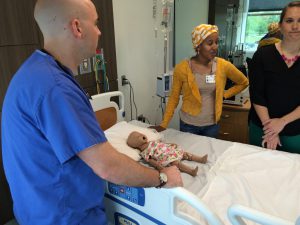Archive for the ‘Rotavirus’ Category
A new vaccine against rotavirus (kills about 600 children a day) worked well in a large trial in Africa and appears to be a practical way to protect millions of children.
Friday, March 24th, 2017- The vaccine is expected to be as cheap as or cheaper than current alternatives.
- It can last for months without refrigeration, which makes it far easier to use in remote villages with no electricity
- It must be approved by the World Health Organization before it can be widely distributed
- About 215,000 children under 5 die each year of rotavirus, almost half of them in just four countries: India, Pakistan, Nigeria and the Democratic Republic of Congo
Rotavirus vaccinations work on Rwandan children
Thursday, January 28th, 2016Effect of pentavalent rotavirus vaccine introduction on hospital admissions for diarrhoea and rotavirus in children in Rwanda: a time-series analysis. Ngabo, Fidele et al. The Lancet Global Health , Volume 4 , Issue 2 , e129 – e136.
Background
In May, 2012, Rwanda became the first low-income African country to introduce pentavalent rotavirus vaccine into its routine national immunisation programme. Although the potential health benefits of rotavirus vaccination are huge in low-income African countries that account for more than half the global deaths from rotavirus, concerns remain about the performance of oral rotavirus vaccines in these challenging settings.
Methods
We conducted a time-series analysis to examine trends in admissions to hospital for non-bloody diarrhoea in children younger than 5 years in Rwanda between Jan 1, 2009, and Dec 31, 2014, using monthly discharge data from the Health Management Information System. Additionally, we reviewed the registries in the paediatric wards at six hospitals from 2009 to 2014 and abstracted the number of total admissions and admissions for diarrhoea in children younger than 5 years by admission month and age group. We studied trends in admissions specific to rotavirus at one hospital that had undertaken active rotavirus surveillance from 2011 to 2014. We assessed changes in rotavirus epidemiology by use of data from eight active surveillance hospitals.
Findings
Compared with the 2009–11 prevaccine baseline, hospital admissions for non-bloody diarrhoea captured by the Health Management Information System fell by 17–29% from a pre-vaccine median of 4051 to 2881 in 2013 and 3371 in 2014, admissions for acute gastroenteritis captured in paediatric ward registries decreased by 48–49%, and admissions specific to rotavirus captured by active surveillance fell by 61–70%.
The greatest effect was recorded in children age-eligible to be vaccinated, but we noted a decrease in the proportion of children with diarrhoea testing positive for rotavirus in almost every age group.
Interpretation
The number of admissions to hospital for diarrhoea and rotavirus in Rwanda fell substantially after rotavirus vaccine implementation, including among older children age-ineligible for vaccination, suggesting indirect protection through reduced transmission of rotavirus. These data highlight the benefits of routine vaccination against rotavirus in low-income settings.


